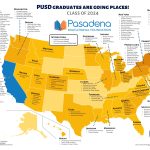Learning History Through Geography
“Thank you so much for providing me the opportunity to apply for a teacher grant. I used the money to purchase historical classroom maps (16 of them!) I started teaching in 1997, and this is the first time that I have had classroom maps that are relevant and necessary for effectively teaching World History. The students are enjoying them as much as I am, so again, THANK YOU!”Historical Pull-down Maps
The PEF Teacher Grant provided funds to purchase historical pull-down maps for the classroom so students can gain a better sense of geography, both past and present.
During the course of the school year, students study civilizations throughout the world, and therefore need to view historical maps that reflect the location as well as the time period of study. As part of the seventh grade History-Social Science Content Standards for California, students are required to study both the history and the geography of the civilizations that developed throughout the Middle Ages.
Aided by the new maps, students now are able to visually locate where a civilization once existed, and they are gaining perspective in terms of the location of the civilization in relation to the rest of the world during the same time period.
The new maps allow Ms. Lira to reference geographical features so her students can analyze the role geography played on decisions such as settlement and trade, and its impact on a civilization’s growth and success. While teaching, the pull-down maps serve as important visual references during discussion and when students are given assignments to label similar maps identifying the key geographic features, names of important places, and the boundaries of the various civilizations being studied.
Using the present-day maps that are currently in the classroom Ms. Lira is now able to have students compare and contrast how the world has changed from ancient to modern times. In addition, the pull-down maps can be written on using a dry erase markers, so students can now interact hands-on with the maps. Students can now get involved with circling key places and drawing arrows indicating trade routes and/or migration patterns.






